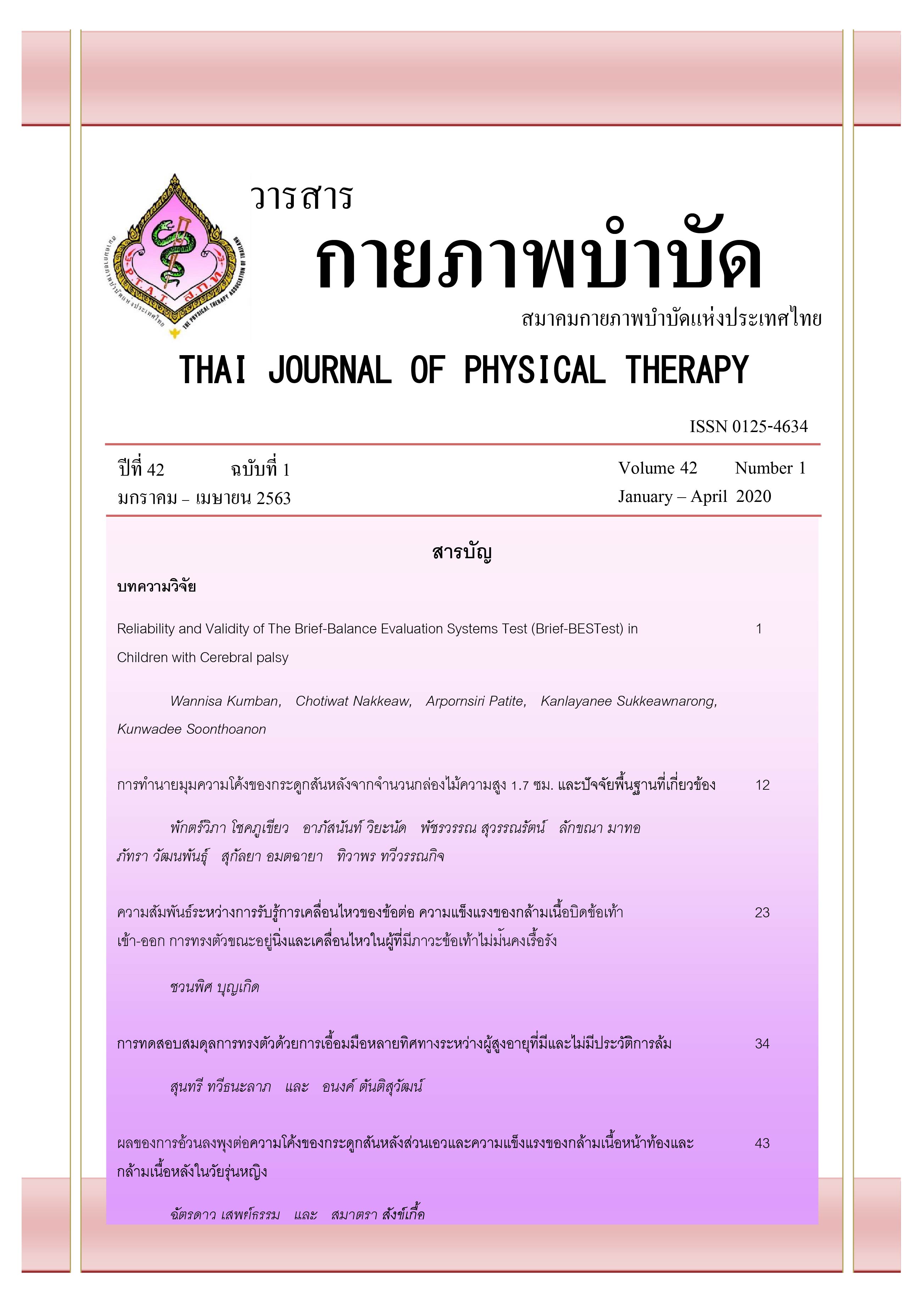ความสัมพันธ์ระหว่างการรับรู้การเคลื่อนไหวของข้อต่อ ความแข็งแรงของกล้ามเนื้อบิดข้อเท้าเข้า-ออก การทรงตัวขณะอยู่นิ่งและเคลื่อนไหวในผู้ที่มีภาวะข้อเท้าไม่มั่นคงเรื้อรัง
Main Article Content
บทคัดย่อ
ที่มาและความสำคัญ: ผู้ที่มีภาวะข้อเท้าไม่มั่นคงเรื้อรังจะมีการสูญเสียการรับรู้การเคลื่อนไหวของข้อต่อ และการลดลงของความแข็งแรงของกล้ามเนื้อซึ่งจะส่งผลต่อการทรงตัวทั้งขณะอยู่นิ่งและเคลื่อนไหว แต่ยังไม่มีการศึกษาใดที่ศึกษาความความสัมพันธ์ระหว่างการรับรู้การเคลื่อนไหวของข้อต่อ ความแข็งแรงของกล้ามเนื้อ การทรงตัวขณะอยู่นิ่งและเคลื่อนไหวในผู้ที่มีภาวะข้อเท้าไม่มั่นคงเรื้อรัง
วัตถุประสงค์: ศึกษาความความสัมพันธ์ระหว่างการรับรู้การเคลื่อนไหวของข้อต่อ ความแข็งแรงของกล้ามเนื้อ การทรงตัวขณะอยู่นิ่งและเคลื่อนไหวในผู้ที่มีภาวะข้อเท้าไม่มั่นคงเรื้อรัง
วิธีการวิจัย: อาสาสมัครเพศชายที่มีภาวะข้อเท้าไม่มั่นคงเรื้อรังจำนวน 21 คน อายุระหว่าง 20-35 ปี ทำการวัดการรับรู้ตำแหน่งของข้อต่อ การรับรู้การเคลื่อนไหวของข้อต่อแบบเคลื่อนที่ให้ และความแข็งแรงของกล้ามเนื้อโดยเครื่อง Isokinetic วัดการทรงตัวขณะอยู่นิ่งโดย Balance Error Scoring System (BESS) และวัดการทรงตัวขณะเคลื่อนไหวโดย Star Excursion Balance Test (SEBT) ทดสอบความความสัมพันธ์ระหว่างการรับรู้ตำแหน่งและการเคลื่อนไหวของข้อต่อ ความแข็งแรงของกล้ามเนื้อ การทรงตัวขณะอยู่นิ่งและเคลื่อนไหวกล้ามเนื้อ โดยใช้ Pearson correlation coefficient
ผลการวิจัย: จากการศึกษานี้พบว่ามีเพียงการรับรู้การเคลื่อนไหวของข้อต่อแบบเคลื่อนที่ให้ในทิศบิดข้อเท้าเข้ามีความสัมพันธ์ในระดับปานกลางกับการทรงตัวขณะเคลื่อนไหวในทิศทางด้านหลังเฉียงทางด้านใน (r=-0.47, p<0.05)
สรุปผล: ในผู้ที่มีภาวะข้อเท้าไม่มั่นคงเรื้อรังพบความสัมพันธ์ระหว่างการรับรู้การเคลื่อนไหวของข้อต่อแบบเคลื่อนที่ให้ในทิศบิดข้อเท้าเข้ากับการทรงตัวขณะเคลื่อนไหวในทิศทางด้านหลังเฉียงทางด้านในเท่านั้น อย่างไรก็ตามยังต้องมีการศึกษาเพิ่มเติมถึงความสัมพันธ์ระหว่าง การรับรู้ของข้อต่อ ความแข็งและของกล้ามเนื้อและการทรงตัวในผู้ที่มีภาวะข้อเท้าไม่มั่นคงเรื้อรัง เพื่อใช้ออกแบบการฝึกที่มีประสิทธิภาพต่อไป
Article Details
เอกสารอ้างอิง
Kim CY, Choi JD, Kim HD. No correlation between joint position sense and force sense for measuring ankle proprioception in subjects with healthy and functional ankle instability. Clin Biomech. 2014; 29: 977-83.
Konradsen L. Factors contributing to chronic ankle instability: Kinesthesia and joint position sense. J of Athl Train. 2002; 37(4):381-5.
Sekir U, Yildiz Y, Haznei B, Ors F, Saka T, Aydin T. Reliability of a functional test battery evaluating functionality, proprioception and strength in recreational athletes with functional ankle instability. Eur J Phys Rehabil Med . 2008; 44: 407-15.
Munn J, Beard DJ, Refshauge KM, Lee Ry. Eccentric muscle strength in function ankle instability. Med Sci Sports Exerc. 2003; 35(2): 245-50.
Han J, Anson J, Waddington G, Adams R, Liu Y. The Role of Ankle Proprioception for Balance Control in relation to Sports Performance and Injury. Biomed Res Int. 2015;2015:842804. doi:10.1155/2015/842804
Refshauge KM, Kilbreath SL, Raymond J. Deficits in detection of inversion and eversion movements among subjects with recurrent ankle sprains. J Orthop Sports Phys Ther. 2003; 33(4):166-73.
Arnold BL, Linens SW, de la Motte SJ, Ross SE. Concentric evertor strength difference and functional ankle instability: A meta-analysis. J Athl Train. 2009; 44(6): 653-62.
Pontaga I. Ankle joint evertor-invertor muscle torque ratio decrease due to recurrent lateral ligament sprains. Clin Biomech (Bristol Avon). 2004; 19(7):760-2.
Iverson GL, Koehle MS. Normative data for the balance error scoring system in adults. Rehabil Res Pract. 2013;2013:846418. doi:10.1155/2013/846418
Gribble PA, Hertel J, Plisky P. Using the star excursion balance test to assess dynamic postural-control deficits and outcomes in lower extremity injury: A literature and systematic review. J Athl Train. 2012; 47(3):339-57.
Docherty CL, Valovich McLeod TC, Shultz SJ. Postural control deficits in participants with functional ankle instability as measured by the balance error scoring system. Clin J Sport Med. 2006; 16(3): 203-8.
Hertel J, Braham RA, Hale SA, Olmsted-Kramer LC. Simplifying the star excursion balance test : analyses of subjects with and without chronic ankle instability. J Orthop Sports Phys Ther. 2006; 36(3): 131-7.
Lee AJ, Lin W. Twelve-week biomechanical ankle platform system training on postural stability and ankle proprioception in subjects with unilateral functional ankle instability. Clin Biomech. 2008; 23: 1065-72.
Huang S, Hiller CE, Pourkazemi F. Measures of balance are not correlated with proprioception at the ankle joint. Br J Sports Med. 2017: 51(Suppl 1):A22.
Simon J, Donahue M, Docherty C. Development of the Identification of Functional Ankle Instability (IdFAI). Foot Ankle Int. 2012; 33(9):755-63.
Han J, Waddington G, Adams R, Anson J, Liu Y. Assessing proprioception: A critical review of methods. J Sport Health Sci. 2016; 5: 80-90.
Lim EC, Tan MH. Side-to-side difference in joint position sense and kinesthesia in unilateral functional ankle instability. Foot Ankle Int. 2009;30(10):1011-7.
Bell DR, Guskiewicz KM, Clark MA, Padua DA. Systematic review of the balance error scoring system. Sports Health. 2011; 3(3): 287-295.
Hyong IH, Kim JH. Test of intrarater and interrater reliability for the star excursion balance test. J Phys Ther Sci. 2014; 26: 1139-41.
Drouin JW, Valovich-mcLeod TC, Shults SJ, Gansneder BM, Perrin DH. Reliability and validity of the Biodex system3 pro isokinetic dynamometer velocity, torque and position measurements. Eur J Appl Ohysiol. 2004;91(1): 22-9.
Lin WH, Liu YF, Hsieh CC, Lee AJ. Ankle eversion to inversion strength ratio and static balance control in the dominant and non-dominant limbs of young adults. J Sci Med Sport. 2009;12(1): 42-9.
Lephart SM, Kocher MS, FU FH, Borsa PA, Harner CD. Proprioception following anterior cruciate ligament reconstruction. J Sports Rehab. 1997;1: 188-96.
Abdel-Aziem AA, Draz AH. Chronic ankle instability alters eccentric eversion/inversion and dorsiflexion/plantarflexion ratio. J Back Musculoskelet Rehabil. 2014; 27: 47–53.
Hall EA, Docherty CL, Simon J, Kingma JJ, Kossner JC. Strength-training protocols to improve deficits in participants with chronic ankle instability: A randomized controlled trial. J Athl Train. 2015; 50(1): 36-44.


